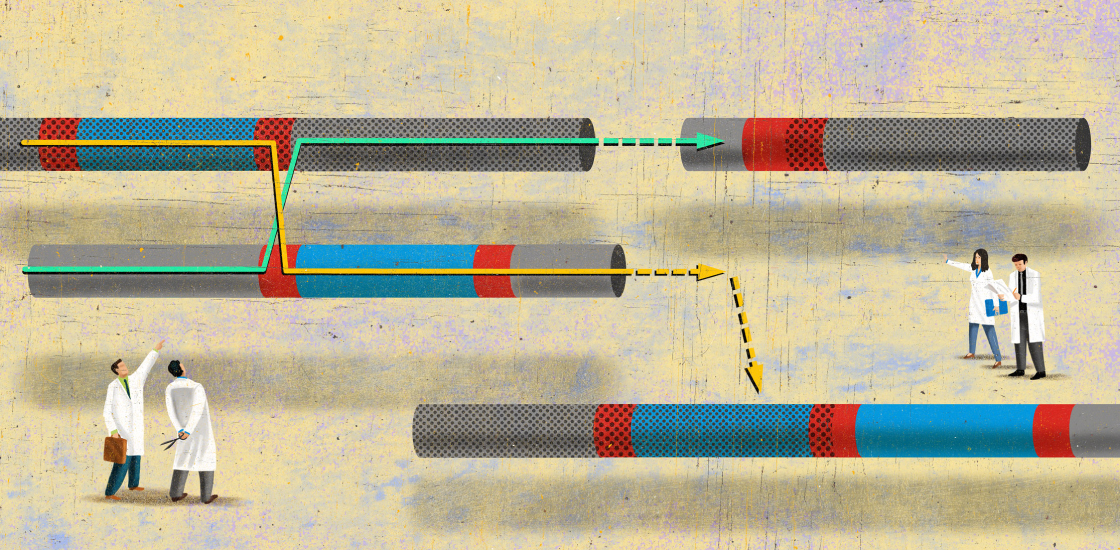THIS ARTICLE IS MORE THAN FIVE YEARS OLD
This article is more than five years old. Autism research — and science in general — is constantly evolving, so older articles may contain information or theories that have been reevaluated since their original publication date.
In a feat of genetic engineering, researchers can now manipulate the DNA of human stem cells to faithfully recreate certain large structural changes that occur in people1. The method could reveal how these genetic glitches sometimes lead to autism.
The new approach takes advantage of the wildly popular CRISPR-CAS9 gene-editing system. The researchers deployed it to engineer stem cells with duplications or deletions of DNA in two chromosomal regions implicated in autism: 15q13.3 and 16p11.2.
The cells show changes in gene expression nearly identical to those seen in cells from people with these same glitches. The finding, published 1 February in Nature Neuroscience, suggests that the tool accurately reproduces these so-called copy number variations (CNVs) in a controlled way.
“CNVs collectively represent a major cause of neurodevelopmental abnormalities, particularly autism,” says lead researcher Michael Talkowski, assistant professor of neurology at Harvard University. “This gives you a fairly robust and repeatable way to model these variations.”
Talkowski and his team presented preliminary data from this study at the American Society of Human Genetics Annual Meeting in Baltimore in October.
Researchers typically create stem cells containing CNVs using skin cells from people who carry these deletions or duplications. But people are genetically diverse, making it hard to pin down effects of the CNV alone. The new method allows researchers to create cells that are genetically identical aside from the presence or absence of the CNV.
“You can really make a clean comparison of the effect of a deletion or duplication in the same region,” says James Noonan, associate professor of genetics at Yale University, who was not involved in the study. “They now have this permanent cellular resource that you can use to really drill down into the molecular biology of what these regions are doing.”
Engineering errors:
Introducing CNVs into cells is difficult because the chromosomal regions are large, contain repeat instances of certain sequences and are flanked by identical segments. The repeated sequences in particular can cause gene-editing tools to make errors by cutting or copying in the wrong place.
CRISPR can be made to cut DNA at both sides of any region to be deleted. But this procedure does not fully replicate a natural CNV, because it ignores the repeated segments that flank the deletion. And it does not work for duplications.
By contrast, the new method takes advantage of a cell’s DNA repair machinery to mimic how CNVs naturally occur. In people, identical DNA sequences bracket the segments that end up being copied or removed. During cell division, those matching regions may stick together, causing the cell’s DNA replication machinery to jump from one copy of a chromosome to the other. The jump can lead to a duplication or a deletion, depending on which regions pair up.
To mimic this natural process, Talkowski and his team deployed CRISPR to nick each of the flanking stretches at the same place. These cuts attract the cell’s repair machinery to fill the gap. Most of the time, the machinery reads the DNA correctly. But roughly 10 percent of the time it jumps between chromosomes, deleting the 16p11.2 region, and about 4 percent of the time, it duplicates it.
For 15q13.3, which is more than double the length of 16p11.2, the technique triggers deletions 5.5 percent of the time, and duplications 1.2 percent of the time.
Quick trick:
This tactic not only yields CNVs that closely match those seen in people, but also allows researchers to efficiently create CNVs in stem cell lines from unaffected people.
The approach generates deletions roughly 10 times more efficiently than existing methods, says Scott Dindot, associate professor of molecular medicine at Texas A&M University, who was not involved in the work. “The technology exists to create these mutations, but it’s very inefficient,” he says. “This is a pretty significant jump.”
The ability to more readily and reliably make deletions and duplications opens up new avenues for research. For example, introducing CNVs into stem cells could allow scientists to compare the effects of the rearrangements in neurons, heart cells and kidney cells — all of which may contribute to the range of symptoms seen in people with CNVs in the 16p11.2 region.
The method may also help researchers pin down which genes within a CNV are responsible for its overall effects.
“The big question in these CNVs is: What are the bad genes?” says Ricardo Dolmetsch, global head of neuroscience at Novartis Institutes for Biomedical Research in Cambridge, Massachusetts. “This is a good way to try to tease that apart.”
Collecting clues:
But some genetic variation is important when screening drugs, Dolmetsch says. Ideally, a treatment would have the same effect on cells regardless of small genetic differences among them. He also cautions that the process of creating variants with CRISPR is not perfect, as it can inadvertently introduce new mutations in the cells.
“In principle, what could be cooler and more powerful than making a mutation in the background you want and comparing the effect of just that mutation against the [normal] cell? But we do need to optimize it a bit,” he says.
Talkowski and his team are continuing to test the method. They are using it to generate CNVs in two more regions tied to autism: 1q21.2 and 22q11.2. They plan to create even more complex structural variations in DNA, such as inverted sequences that flank duplications or deletions.
These experiments will be challenging, but CRISPR is proving up to the task, says Noonan. “It’s amazing what this stuff can do.”

By joining the discussion, you agree to our privacy policy.